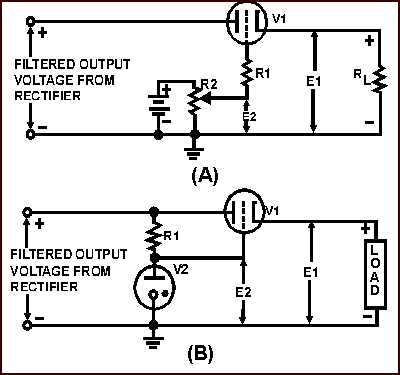3-45
Figure 3-48.—Electron tube voltage regulator using a battery for the fixed bias
If the rectifier output voltage increases, the voltage at the cathode of V1 tends to increase. As E1
increases, the negative bias on the tube increases and the plate resistance of the tube becomes greater.
Consequently, the voltage drop across V1 increases with the rise in input voltage. If the circuit is designed
property, the increased voltage drop across V1 is approximately equal to the increase in voltage at the
input. Thus the load voltage remains essentially constant.
The resistor (R1) is used to limit the grid current. This is necessary in this particular circuit because
the battery is not disconnected when the power is turned off. However, the battery can be eliminated from
the circuit by the use of a glow tube (V2), as shown in view (B) of the figure, to supply a fixed bias for
the grid of the tube. The action of the circuit in view (B) is the same as the action of the circuit in view
(A). The output voltage of the simple voltage regulators shown in the figure cannot remain absolutely
constant. As the rectifier output voltage increases, the voltages on the cathode of V1 must rise slightly if
the regulator is to function.
The voltage regulators shown in the figure compensate not only for changes in the output voltage
from the rectifier, but also for changes in the load. For example, in view (B) if the load resistance
decreases, the load current will increase. The load voltage will tend to fall because of the increased drop
across V1. The decrease in load voltage is accompanied by a decrease in bias voltage on V1. The bias
voltage on V1 is equal to E1 - E2. Thus the effective resistance of V1 is reduced at the same time the load
current is increased. The IR drop across V1 increases only a slight amount because R decreases about as
much as I increases. Therefore, the tendency for the load voltage to drop when the load is increased is
checked by the decrease in resistance of the series triode.
Q40. In an electron tube regulator, the electron tube replaces what component?



